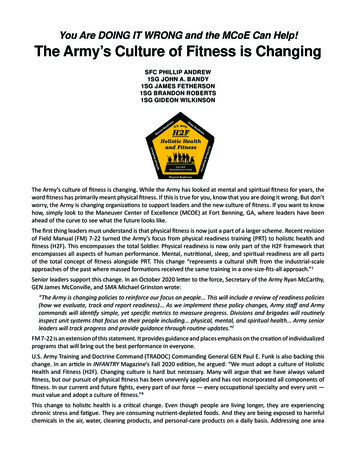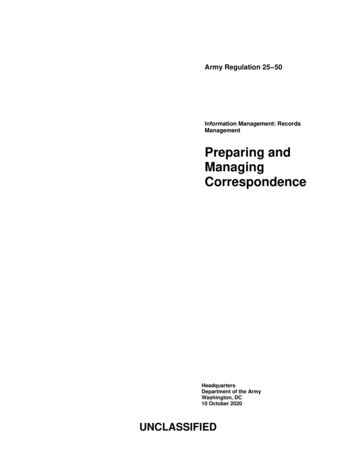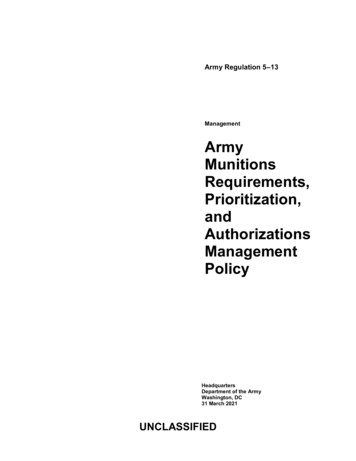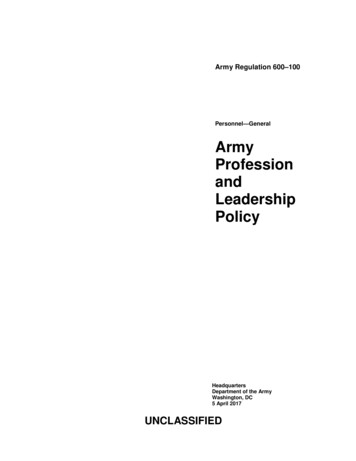
Transcription
You Are DOING IT WRONG and the MCoE Can Help!The Army’s Culture of Fitness is ChangingSFC PHILLIP ANDREW1SG JOHN A. BANDY1SG JAMES FETHERSON1SG BRANDON ROBERTS1SG GIDEON WILKINSONThe Army’s culture of fitness is changing. While the Army has looked at mental and spiritual fitness for years, theword fitness has primarily meant physical fitness. If this is true for you, know that you are doing it wrong. But don’tworry, the Army is changing organizations to support leaders and the new culture of fitness. If you want to knowhow, simply look to the Maneuver Center of Excellence (MCOE) at Fort Benning, GA, where leaders have beenahead of the curve to see what the future looks like.The first thing leaders must understand is that physical fitness is now just a part of a larger scheme. Recent revisionof Field Manual (FM) 7-22 turned the Army’s focus from physical readiness training (PRT) to holistic health andfitness (H2F). This encompasses the total Soldier. Physical readiness is now only part of the H2F framework thatencompasses all aspects of human performance. Mental, nutritional, sleep, and spiritual readiness are all partsof the total concept of fitness alongside PRT. This change “represents a cultural shift from the industrial-scaleapproaches of the past where massed formations received the same training in a one-size-fits-all approach.”1Senior leaders support this change. In an October 2020 letter to the force, Secretary of the Army Ryan McCarthy,GEN James McConville, and SMA Michael Grinston wrote:“The Army is changing policies to reinforce our focus on people. This will include a review of readiness policies(how we evaluate, track and report readiness). As we implement these policy changes, Army staff and Armycommands will identify simple, yet specific metrics to measure progress. Divisions and brigades will routinelyinspect unit systems that focus on their people including. physical, mental, and spiritual health. Army seniorleaders will track progress and provide guidance through routine updates.”2FM 7-22 is an extension of this statement. It provides guidance and places emphasis on the creation of individualizedprograms that will bring out the best performance in everyone.U.S. Army Training and Doctrine Command (TRADOC) Commanding General GEN Paul E. Funk is also backing thischange. In an article in INFANTRY Magazine’s Fall 2020 edition, he argued: “We must adopt a culture of HolisticHealth and Fitness (H2F). Changing culture is hard but necessary. Many will argue that we have always valuedfitness, but our pursuit of physical fitness has been unevenly applied and has not incorporated all components offitness. In our current and future fights, every part of our force — every occupational specialty and every unit —must value and adopt a culture of fitness.”³This change to holistic health is a critical change. Even though people are living longer, they are experiencingchronic stress and fatigue. They are consuming nutrient-depleted foods. And they are being exposed to harmfulchemicals in the air, water, cleaning products, and personal-care products on a daily basis. Addressing one area
SGM Daniel Lai from the U.S. Army Human Resources Command warms up for the deadlift prior to performing apractice Army Combat Fitness Test at Fort Eustis, VA, on 25 October 2019. (Photo by MSG Michel Sauret)of fitness while ignoring others often leaves problems unaddressed and leads to discouraging results. Broadeningone’s view of fitness is important because we have to view and support the body as the incredible system it is inorder to achieve optimal wellness.This does not mean cultural change will be easy, and there are several hurdles that leaders must overcome toaffect change. Some recent developments provide opportunities for change.Physical ReadinessThe first obstacle is the required shift in focus from increasing the fitness level of the group to raising the fitnesslevel of the individual.⁴ Soldiers of the World War I era conducted calisthenics and body-weight exercises inmass formations. More than 100 years later, we are still primarily conducting physical fitness training with bodyweight exercises in large groups and with very little focus on the individual.⁵ We still think large formation runsare necessary to build esprit de corps, and planning basic traditional body-weight workouts in formations is stillthe easy choice for company-level leaders stuck in a high-operations tempo (OPTEMPO) environment that leaveslittle time to innovate and plan. The challenges of COVID-19, however, might have a silver lining in this regard, asleaders spent most of 2020 conducting individual physical training or only gathering in small groups. This providedan unexpected opportunity for a cultural shift.A lack of required equipment has also historically constrained individualized physical training. Without a varietyof medicine balls or weights, each suitable for a different type of person, mass formations and body-weighttraining provided the greatest payoff for time. The new Army Combat Fitness Test (ACFT) changes this. Thoughthe Army initially faced major logistical issues fielding equipment for the ACFT, units now have a variety of ACFTtraining equipment in various forms all across the Army. Units no longer need to reserve limited gym space orfight for scarce resources. Leaders today find themselves with a capability for individualized training that previousgenerations of leaders could only dream about.Ensuring decision makers have the knowledge needed for individualized training is another hurdle. Individualizedtraining must be managed at the squad level where the trust and knowledge exists between squad mates toensure proper individual care. While master fitness trainers (MFTs) have been around for a while, there have neverbeen enough for each squad in the Army. Instead, MFTs are usually an afterthought — a check the block for anadditional duty.This lack of knowledge is exacerbated by overconfidence in leaders. Many have their own preferred workoutstyle and think this makes them an expert across the board. It seems like every battalion-level leader is a masterof running form, every young captain thinks he is an expert on CrossFit, and every young staff sergeant says he
knows the right way to lift. But most company commanders, first sergeants, and sergeants major are not properlytrained or equipped to create individually tailored physical training programs. Worse still, some leaders simply relyon perseverance and grit fueled on coffee and nicotine instead of science-based training protocols. This leads toplanning and executing training with a narrow perspective. Experienced and battle-hardened NCOs often plan andexecute training based simply on what has worked for them in the past. All too often the underperforming Soldiersthey lead are told to suck it up like they had to.To overcome these obstacles, the Army is building institutions and changing organizations. The MCoE is leading thischange with the Fort Benning Tactical Athlete Performance Center (TAP-C), a state-of-the-art facility that opened inMarch of 2019 with the ability to train, assess, and provide individualized programs. The facility can train up to 180Soldiers at once. Not only does the TAP-C provide individually tailored training, it provides education that primarilyfocuses on training leaders. This training provides the tools necessary for leaders to return to their units andidentify deficiencies within their formations and create training programs. These training programs are tailored toindividuals, addressing their deficiencies with a holistic approach to health and fitness.TAP-C’s main training program is the Performance Extender Program. The program is led by a strength andconditioning coach who is assisted by other trained and certified Soldiers from the installation. It provides a oneon-one approach to educate leaders on correct movement patterns and the scientific principles behind H2F. Italso includes training on micro-design: how to properly incorporate anaerobic, strength, aerobic, endurance andrecovery days into their day-to-day Army schedules. This would also include how to account for planned rangedays and mandatory physical training events.This curriculum is the cutting-edge of modern physical training. It is the same training that allows today’sprofessional athletes to be faster and stronger than those in previous decades. But while professional athletes mayuse advances in science to push the envelope, today’s military leaders have the inverse problem: how to bridgethe gap between the sedentary lifestyle of the average American and give them the tools and training to becomeathletes capable of combat.Mental Readiness“Mental readiness is the capacity to adapt successfully in the presence of risk and adversity.”⁶ Installations acrossthe Army have been pushing for all Soldiers to be ready and resilient (R2). Fort Benning teaches its Soldiers tobe mentally fit through the R2 program. The TAP-C works alongside the performance psychologists employed byThe goal of the Tactical Athlete Performance Center on Fort Benning is to increase Soldierreadiness, lethality, survivability, sustainability, and retention through education andtraining. (Photo by Markeith Horace)
R2 to teach Soldiers how to use the skills learned through yearly resiliency training and apply them in real-worldsituations. FM 7-22 broadens the understanding of mental readiness stating that mental readiness depends on fivefactors: character, behavior, resilience, cognitive skill, and social acuity.Spiritual ReadinessUnits across Fort Benning utilize chaplains to increase spiritual readiness within Soldiers. Chaplains host spiritualevents that help prepare Soldiers for challenges they may face in the future. They develop spiritual readinessthrough discussions on faith, scripture, and the importance of interpersonal communication in order to buildhealthy relationships. Several of the initial military training (IMT) chaplains attend workshops with their unit’sdrill sergeants at the TAP-C. The 199th Infantry Brigade Chaplain hosts spiritual retreats such as the Strong Bondsprogram for married and single Soldiers alike. Another great effort is from the 3rd Battalion, 81st Armor Regimentchaplain, who is linking spiritual and physical fitness by hosting “Spiritual Fitness Hikes” at Providence Canyon inLumpkin, GA.Nutritional ReadinessFort Benning is also making changes to its dining facilities (DFACs); clearly labeled foods are now put in order ofprecedence of which are most healthy to least healthy. The “Go for Green” campaign highlights the healthiest“green” options first so Soldiers fill up their plates with the healthiest foods before moving further down the lineto the less healthy yellow and red categorized foods. The goal is to have Soldiers reach for the most nutritiousoptions first. For many new Soldiers going through IMT, the DFACs may be the first time they are introduced tohow to make healthy eating choices. Fort Benning DFACs are also educating more than just new trainees; they alsoreach Soldiers attending many of the professional military education (PME) courses in addition to those assignedas permanent party. There are many options available besides the DFACs to include fast food establishmentsavailable on and off post that are convenient. Eating healthy will continue to require the discipline of making smartchoices. Idealistically through the indoctrination and experience established beginning with IMT and reinforcedthrough PME, Soldiers will make the healthiest choices no matter where they eat.The Army’s utilization of strength and conditioning coaches is a critical aspect in the continuing commitment of theArmy’s culture of fitness. However, most installations will take several years to develop brigade-level H2F facilities.The Fort Benning TAP-C is fortunate to have several strength and conditioning coaches. The TAP-C is responsiblefor teaching lifelong fitness and movement skills, improving athletic performance, and reducing injuries whichultimately leads to increasing physical dominance and lethality capabilities. To make positive change across theforce, leaders at multiple levels need educational development and increased familiarization with using strengthand conditioning coaches. Training Soldiers attending MCoE PME courses accomplishes this. The strength andconditioning coaches at the TAP-C currently train future Army leaders across all career branches by developingSoldiers attending Officer Candidate School (OCS). They further influence the culture of fitness by working withstudents from the Infantry Basic Officer Leader Course (IBOLC), Maneuver Senior Leader Course (MSLC), andManeuver Captains Career Course (MCCC). Each year, thousands of leaders will be able to take and apply the skillsthey learn at the TAP-C to influence change in the culture of the U.S. Army, which is the ultimate goal of H2F.Notes¹ FM 7-22, Holistic Health and Fitness, October 2020. Retrieved from https://armypubs.army.mil/epubs/DR pubs/DR a/ARN30714-FM 7-22-000-WEB-1.pdf.² Secretary of the Army Ryan McCarthy, GEN James McConville, and SMA Michael Grinston, “Focus on Its PeopleIs No. 1 Army Priority,” Fort Campbell Courier, 15 October 2020, accessed from https://fortcampbell-courier.com/army messaging/article 32aa915e-0f5f-11eb-85be-ffb3921532a2.html.3GEN Paul E. Funk II, “Maintenance – People Readiness,” INFANTRY Magazine (Fall 2020): 42.⁴ D.J. Bigham, “Improving the Army’s Physical Training Culture with the Tactical Athlete Performance Center (TAP-C)at the Maneuver Center of Excellence (MCoE),” 6 November 2018.⁵ Ibid.⁶ FM 7-22, 3-9.
SFC Phillip Andrew served as the first sergeant (1SG) for the Maneuver Center of Excellence (MCoE) Band at FortBenning, GA. His next assignment will be as a small group leader for the Army Band’s Senior Leader Course at theU.S. Army School of Music at Naval Amphibious Base Little Creek in Norfolk, VA.1SG John A. Bandy currently serves as the 1SG for A Company, 3rd Battalion, 81st Armor Regiment (MCoEHeadquarters and Headquarters Company), Fort Benning.1SG James Fetherson currently serves as the 1SG for B Company, 3-81 AR and Maneuver Captains Career Course.1SG Brandon Roberts currently serves as 1SG for C Company, 3-81 AR, International Military Student Office.1SG Gideon Wilkinson served as 1SG for HHC, 199th Infantry Brigade, Fort Benning. He is currently serving as 1SGfor B Troop, 6th Squadron, 1st Cavalry Regiment, 1st Brigade Combat Team, 1st Armored Division, at Fort Bliss, TX.
Magazine’s Fall 2020 edition, he argued: “We must adopt a culture of Holistic Health and Fitness (H2F). Changing culture is hard but necessary. Many will argue that we have always valued fitness, but our pursuit of physical fitness has been unevenly applied and has not











